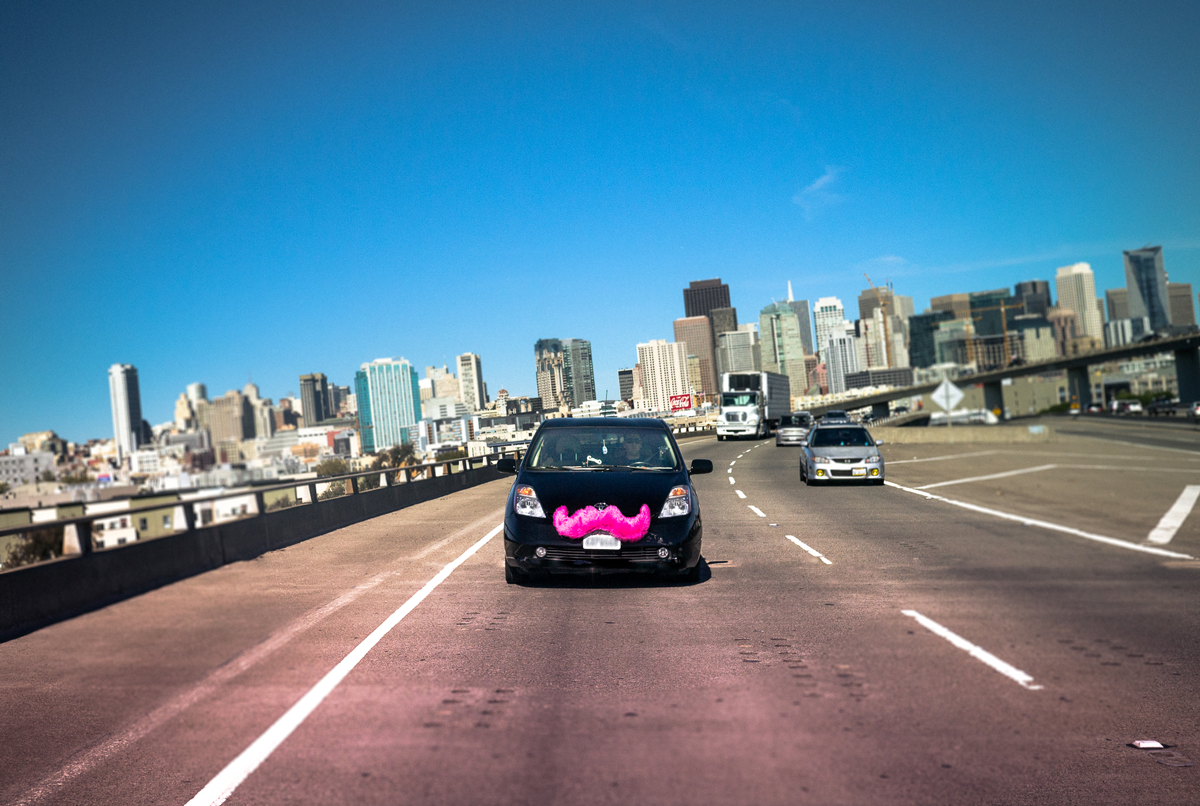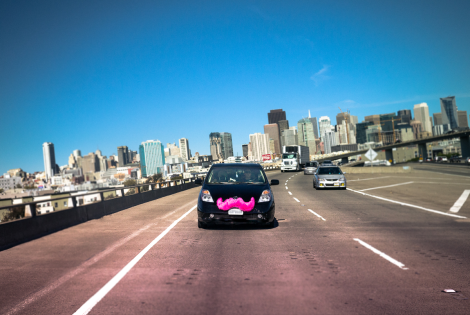They’ve been around since 2010, but over the last year, “ridesharing” services such as Uber, Lyft, and Sidecar have established themselves as serious transportation players in major American cities. But the road has been a bumpy one — and so far, this part of the “sharing economy” looks less like an altruistic act, and more like a shadow service industry with few consumer or worker protections.
This was the theory of the rideshare: You’re going to a meeting across town, and you have three empty seats in your car. Why not match those seats with riders in need, maybe with some help from a phone app? And hey, maybe they’ll even chip in for some gas.
But that’s not what “rideshare” has come to mean in practice. Sidecar, Uber, Lyft, and other similar services skirt car-for-hire regulations by insisting that their drivers are not professionals. But some of these services set clear fares, like taxis, and even when payment is in the form of a “suggestion donation,” riders can read between the lines.
And that cash is not meant to just cover the gas for your ride. The Lyft driver sign-up page reads: “Drivers are making up to $35/hour + choosing their own hours!” The message is clear: This is a job, or at least a job opportunity — not an act of sharing.
Given all this, it’s no surprise that ridesharing companies have been hitting roadblocks with municipalities and state regulatory agencies — or that the furry pink mustache Lyft drivers zip-tie to their grills has become a symbol of “disruption” on San Francisco streets.
This week things came to a head in the Bay Area, as rideshare companies warned drivers to avoid the airport, where they could be slapped with potential fines and even citizen’s arrest. San Francisco taxi drivers rallied, demanding the city crack down on ridesharing businesses that they say are taking a bite out of their bottom line, and face none of the regulations that taxis do. And the California Public Utilities Commission finally released its long-awaited recommendations [PDF] for bringing ridesharing companies into compliance with state laws.
How this all plays out will be the next big test case for the widespread success and acceptance of the sharing economy.
How did we get here? Ridesharing, of course, has its roots in old-school carpooling. The Bay Area’s Casual Carpool program is still going strong, powered by tech that’s still circa 2000. No cash changes hands; the incentive for drivers is that, with a carpooler or two along, they get to drive in the faster HOV lane — similar to “slugging” in the D.C. area.
Like earlier carpooling efforts, rideshare companies have done particularly well in sprawlier metro areas, where our infrastructure was made for driving (so that’s just what we’ll do …). Cities like Los Angeles are “becoming too dense for cars and not dense enough for conventional transit,” California Air Resources Board member Dan Sperling told Southern California Public Radio.
“Surveys by ridesharing companies promote the idea that their service complements mass transit; Sidecar found that, after ridesharing, 53 percent of people who use its service also use public transportation — almost double the response for cars,” reports SCPR’s Molly Peterson.
That’s helped to make ridesharing a priority for some local government agencies looking to cut greenhouse gas emissions, especially in California. And the techies and “sharing” boosters point out that ridesharing allows us to “leverage excess idle capacity” — that is, fill empty seats — and therefore operate more efficiently.
But let’s be honest about this “excess idle capacity” thing. Ridesharing may be a peer-to-peer economy — moderated by middlemen — but this is not really “sharing.”
“I make more money driving for Lyft per hour than I have doing anything else,” says Kate Dollarhyde, an Oakland resident who makes a living giving people rides in San Francisco. Though Lyft riders are presented with a “suggested donation,” rather than a set fee, Dollarhyde says almost all pay the full amount plus a tip.
It’s a transaction that, save for that pink mustache, looks basically just like a cab ride. “The big difference between the Lyft experience and the cab experience is supposedly friendliness — that’s why they bill themselves as ‘your friend with a car,'” Dollarhyde says. “I’m sure it’s different for everyone, but for me it’s hard to be ‘on’ all the time. It’s a job first and foremost and a way to connect with strangers a distant second.”
This is precisely the issue that bothers taxi drivers like Tyler Hutton. “You have a group of people who are driving commercially and claiming they’re not driving commercially,” he says. “They are now part of the fabric of passenger vehicle transportation in the city.”
Hutton has been driving a Luxor cab in San Francisco for seven years, but says he’s making about two-thirds of what he did last year. “I think every single person is making less money than they made last year,” he says.
In this flagging economy, ridesharing companies are job creators — and killers.
But are we better off collectively, environmentally? That’s less clear.
San Francisco required its taxi cabs to become hybrids or natural-gas-powered by 2012. And while rideshare companies claim they contribute to a reduction in greenhouse gas emissions, most have no similar requirements. (UberX’s hybrid fleet is a notable exception.)
Carshare services do offer consumers alternatives to the cab companies that have long had a stranglehold on car-for-hire services in many cities. While business may be down for Hutton and his colleagues, there’s no heartburn from (former) cab customers: Between July 1, 2011 and June 30, 2012, passengers lodged more than 1,700 official complaints against San Francisco cabs.
But cab companies are also responsible for insuring and maintaining their vehicles, costs that come directly out of rideshare drivers’ own pockets — if they can afford it. And even when they get those complaints, cab drivers have labor union protections. Ridesharers can review their drivers directly on drivers’ online profiles, which has the potential to immediately damage a driver’s livelihood.
And the cab companies have a point when they complain about rideshare drivers being exempt from regulations.
“Yes, San Francisco needs more taxis, and they’ve added more, but the reason you regulate the number of the taxis in the city is so everybody is able to make a little bit of money, and you’re able to maintain standards,” says Hutton. “Standards are really important in transportation because if you don’t have standards, people die.”
The California Public Utilities Commission’s decision to dip its toe into regulating these businesses was heralded as a huge win this week for Uber, Lyft, Sidecar, et. al. The suggested regs would, among other requirements, raise insurance minimums and force rideshare companies to run background checks, which some of them already do. But by finally codifying ridesharing, they would give these companies a degree of legitimacy that they don’t currently enjoy.
Still, in its recommendations, the commission defines ridesharing as a nonprofit endeavor — which is very explicitly not what rideshare startups are doing.
There are other concerns as well. Both Hutton and Dollarhyde point out the cultural differences between cabs and rideshare cars. “A lot of my customers tell me they prefer Lyft because they feel more safe than they do in cabs, and also because they feel they can talk to and make friends with drivers,” says Dollarhyde. “I get a sense of subtly veiled racism regarding cabbies in some of these conversations.”
In a conversation with SPCR’s Peterson, one Los Angeles transportation advocate “questions whether these ride-sharing companies are going to ‘skim off’ choice, young, affluent riders … possibly starving public transit’s fan base.”
If private car ownership is not our future (fingers crossed), these companies — in some regulated, tax-paying form — could play a significant role in how we get around our cities. But that doesn’t mean we should only view them through pinko-commie-rose-tinted “sharing economy” glasses. These are businesses with big money looking at shaking up our transit systems to make more big money — not as an altruistic, community-building act.
Case in point: This week, 22 industry partners teamed up to launch Peers.org, a lobbying effort on the part of this nebulous, ill-defined “sharing economy.” Among the Peers funders are many of the disruptive, tech-enabled peer-to-peer startups, including Lyft and Sidecar, that could benefit from a friendly face lobbying for their businesses at city halls and state regulatory commissions (though they’ve already hired their own fancy attorneys).
These startups may well have a long-term positive net effect on taking more cars off the road and reducing total transportation emissions. Frankly, we don’t really know yet. But personally, I’m more concerned about filling the extra seats on our public buses and trains.





